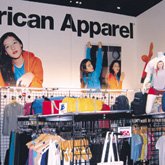Color Pervades ISS
The buzz in the T-shirt community this year is all about color.
Think wild colors such as American Apparel’s bright neons, which shock the eyes in vivid greens, oranges, blues, pinks and yellows.
The Los Angeles company is taking those vivid hues and knitting them into polyester/cotton V-necks that will come in a range of sizes, all the way up to XXL. They almost glow in the dark.
Or Gildan, a Montreal-based T-shirt company that has piled on 28 new shades to bring its merchandise palette to 98 hues. The new colors range from teal ice and gravel (think gray) to antique heliconia and russet, which is as brown as a potato.
“Everyone wants color,” said Bruce Berton, chief operating officer at Roochi Traders Inc., a Commerce, Calif., company, whose Cotton Heritage label is rife with vibrant offerings such as hot pink, cardinal and purple.
Color exploded everywhere on the floor of the Imprinted Sportswear Show, the annual event at the Long Beach Convention Center in Long Beach, Calif., where blank T-shirt and fleece-top companies show their wares alongside machines that do everything from silk screening 1,400 T-shirts in one hour to creating 3-D embroidery with lasers that are four or five times faster than traditional embroidery machines.
The show, which ran Jan. 20–22, was much busier than last year. There were 350 exhibitors this year. That is the same amount as last year, but the exhibitors took 5 percent more square footage.
That was good news for an industry that was challenged in 2011 with steep hikes in cotton prices that topped $2 a pound. In recent months, cotton costs have shrunk to about $1 per pound, and everyone is hoping that it holds at that level or declines even more.
However, few companies were stepping up to reduce prices. Most companies said they are taking a wait-and-see attitude.
Jim Gordon, Western regional sales manager for Alstyle Apparel in Anaheim, Calif., said the company buys cotton futures four or five months in advance and can’t lower prices at the moment. “Even though cotton is down, we still have that [cotton] in inventory,” he said.
Gildan was also taking a cautious approach to prices.
Meanwhile, Cotton Heritage, which sources its T-shirts from factories in Bangladesh and India and its fleece tops from China and Pakistan, has trimmed its prices by 10 percent on some goods after taking seven price increases last year that added up to a 15 percent rise in wholesale prices in 2011. “We think cotton prices will stabilize over the next six months,” Berton said.
Tops with a twist
On the style side of the business, color wasn’t the only standout trend. Popular silhouettes included a plethora of V-neck T-shirts for men. For the misses customer, T-shirt companies were offering a top that had more shape and fitted more snugly. “Our misses styles are less boxy,” said Alstyle’s Gordon, pointing to a more youthful-looking T-shirt. “This side seam makes it fit, and the ring-spun cotton makes it soft.”
Gildan also was introducing a misses T-shirt that was more flattering. “It is for the woman who wants a form-fitting shirt with some wiggle room,” said Karla Schoenfeld, the company’s marketing director.
Burnout T-shirts were still on top of a trend that started a few years ago, but this year there were more print-like looks. Cotton Heritage had a paisley-printed burnout shirt.
Kavio, based in Commerce, Calif., maximized the trend with burnout shirts that had everything from zebra designs to flower sublimation.
This year, many companies were taking last year’s twist on burnout and making it less transparent, which was particularly true on the menswear side.
Quality vs. quantity
For some T-shirt labels, the selling point this year was their “ Made in USA” roots or their cotton quality.
Bella + Canvas, the Los Angeles T-shirt company formerly known as Bella, was taking great care to let the world know that its cotton T-shirts are made only of combed and ring-spun cotton, which is softer and smoother than carded and open-end cotton, which has a rougher feel. The company produced a four-minute video that showed all the ups and downs of the two types of cotton.
The company was also playing up its “Made in the USA” styles, manufactured at its headquarters, which produces more than 10 million units every year.
Also playing on its USA origins was US Blanks, which merged more than one year ago with Antex Knitting Mills, located in downtown Los Angeles. “Demand for U.S.-made products increased dramatically in the last quarter of last year,” said Kevin Kelly, president of US Blanks. “We are a totally vertical operation that occupies three city blocks.”
He pointed out that the fabric is knit in downtown Los Angeles as well as cut and sewn there, too.
In addition, US Blanks wants to enter the eco market. It will be introducing a 100 percent recycled cotton T-shirt in March as well as following up on more-luxurious products with its 10 percent silk/90 percent Modal fabric, which produces a soft, cashmere feel.
For Pima Apparel, whose 2011 revenues held steady at $10 million, it was all about new products to boost sales. Jack Zhang, executive vice president of the Ontario, Calif.–based company, which makes all its shirts in China, said the company was betting on a T-shirt made of 85 percent polyester and 15 percent linen that wholesales for $3.95 for a women’s top and $4.60 for a men’s. Last year, the company was betting on a soybean/bamboo shirt, but it failed to catch on, Zhang said.

























